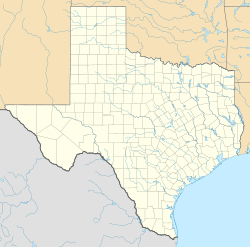Robert Gray Army Airfield
Airport in Fort Cavazos / Killeen, Texas From Wikipedia, the free encyclopedia
Robert Gray Army Airfield[1] (IATA: GRK, ICAO: KGRK, FAA LID: GRK) is a military joint-use airport that operates alongside Killeen Regional Airport.[2] The airport is based inside the south end of the Fort Cavazos Military Reservation (West Fort Hood), six nautical miles (7 mi, 11 km) southwest of the central business district of Killeen, Texas,[2] in unincorporated Bell County.
Robert Gray Army Airfield Robert Gray Air Force Base (former Camp Hood Air Force Base) (former Killeen Army Airfield) | |||||||||||
|---|---|---|---|---|---|---|---|---|---|---|---|
 USGS 2006 orthophoto | |||||||||||
| Summary | |||||||||||
| Airport type | Public / Military | ||||||||||
| Owner | U.S. Army ATCA-ASO | ||||||||||
| Location | Fort Cavazos / Killeen, Texas | ||||||||||
| Elevation AMSL | 1,015 ft / 309 m | ||||||||||
| Coordinates | 31°04′02″N 097°49′44″W | ||||||||||
| Map | |||||||||||
 | |||||||||||
| Runways | |||||||||||
| |||||||||||
| Statistics (2010) | |||||||||||
| |||||||||||
As per Federal Aviation Administration records, the airport had 232,299 passenger boardings (enplanements) in calendar year 2008,[3] 231,500 enplanements in 2009, and 243,861 in 2010.[4] It is included in the National Plan of Integrated Airport Systems for 2011–2015, which categorized it as a primary commercial service airport (more than 10,000 enplanements per year).[5]
History
The base was named after a Killeen native who was a pilot of a B-25 bomber on the famous Doolittle Raid on Tokyo in 1942. He was killed later in World War II flying combat missions.[6]
Facilities and aircraft
The airport has one runway designated 15/33 with a PEM (Porous European Mix) surface measuring 10,000 by 200 feet (3,048 x 61 m). For the 12-month period ending April 10, 2010, the airport had 12,208 aircraft operations, an average of 33 per day: 98.5% scheduled commercial and 1.5% general aviation.[2]
The base is also served by Yoakum–DeFrenn Army Heliport (IATA: HLR, ICAO: KHLR, FAA LID: HLR) and two asphalt auxiliary landing strips used for training at North Fort Hood:
- Shorthorn Aux Landing Strip (FAA LID: 23XS) – 2,130 by 46 feet (649 m × 14 m) (RWY 15 1,583 feet (482 m) usable, RWY 33 1,897 feet (578 m) usable) at 31.361°N 97.673°W, elevation 720 feet (220 m), magnetic variation 5.1° E[7][8]
- Longhorn Aux Landing Strip (FAA LID: 22XS) – 3,490 by 75 feet (1,064 m × 23 m) (unmarked numbers, but same magnetic heading as Shorthorn at 153 degrees) at 31.374°N 97.667°W, elevation 720 feet (220 m), magnetic variation 5.1° E[9][10]
See also
References
Other sources
External links
Wikiwand - on
Seamless Wikipedia browsing. On steroids.

